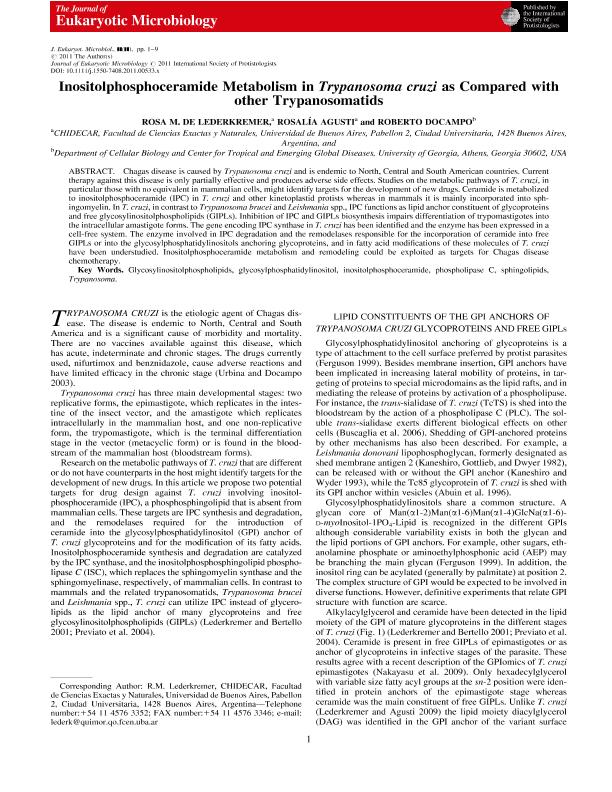Artículo
Inositolphosphoceramide metabolism in Trypanosoma cruzi as compared with other trypanosomatids
Fecha de publicación:
03/2011
Editorial:
Wiley Blackwell Publishing, Inc
Revista:
Journal of Eukaryotic Microbiology
ISSN:
1066-5234
Idioma:
Inglés
Tipo de recurso:
Artículo publicado
Clasificación temática:
Resumen
Chagas disease is caused by Trypanosoma cruzi and is endemic to North, Central and South American countries. Current therapy against this disease is only partially effective and produces adverse side effects. Studies on the metabolic pathways of T. cruzi, in particular those with no equivalent in mammalian cells, might identify targets for the development of new drugs. Ceramide is metabolized to inositolphosphoceramide (IPC) in T. cruzi and other kinetoplastid protists whereas in mammals it is mainly incorporated into sphingomyelin. In T. cruzi, in contrast to Trypanosoma brucei and Leishmania spp., IPC functions as lipid anchor constituent of glycoproteins and free glycosylinositolphospholipids (GIPLs). Inhibition of IPC and GIPLs biosynthesis impairs differentiation of trypomastigotes into the intracellular amastigote forms. The gene encoding IPC synthase in T. cruzi has been identified and the enzyme has been expressed in a cell-free system. The enzyme involved in IPC degradation and the remodelases responsible for the incorporation of ceramide into free GIPLs or into the glycosylphosphatidylinositols anchoring glycoproteins, and in fatty acid modifications of these molecules of T. cruzi have been understudied. Inositolphosphoceramide metabolism and remodeling could be exploited as targets for Chagas disease chemotherapy.
Archivos asociados
Licencia
Identificadores
Colecciones
Articulos(CIHIDECAR)
Articulos de CENTRO DE INVESTIGACIONES EN HIDRATOS DE CARBONO
Articulos de CENTRO DE INVESTIGACIONES EN HIDRATOS DE CARBONO
Citación
Muchnik, Rosa; Agusti, Rosalia; Docampo, Roberto; Inositolphosphoceramide metabolism in Trypanosoma cruzi as compared with other trypanosomatids; Wiley Blackwell Publishing, Inc; Journal of Eukaryotic Microbiology; 58; 2; 3-2011; 79-87
Compartir
Altmétricas




